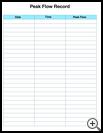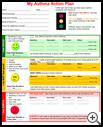
Peak Flow Meter: Teen Version
________________________________________________________________________
KEY POINTS
- Asthma is a chronic lung disease that causes symptoms like coughing, wheezing, and shortness of breath.
- A peak flow meter is a small hand-held device that measures how well air moves out of your lungs. It does this by measuring how fast you can blow air out of your lungs.
- Peak flow readings tell you if your asthma is under good control, if you need to take medicines, or if you need to get help right away.
- Each brand of peak flow meter works a little differently. Make sure you know how to use your peak flow meter correctly
________________________________________________________________________
What is asthma?
Asthma is a long-lasting (chronic) lung disease. It causes symptoms like coughing, wheezing, and shortness of breath.
Asthma symptoms are caused by two different problems in the airways.
- One problem is that the muscles in the airways tighten up, which causes the feeling of chest tightness and wheezing.
- The other problem is swelling, irritation and too much mucus in the airways.
If you have asthma, symptoms often start after you are exposed to a trigger. Asthma triggers can include:
- Irritants such as cold air, chemicals, perfume, pollution, and smoke
- Things you might be allergic to such as dust, pollen from plants and trees, molds, foods (like peanuts), animal dander, and medicines (like aspirin)
- Illnesses like the flu, a cold, or a sinus infection
- Physical activity (called exercise-induced asthma)
- Indigestion, also called gastroesophageal reflux disease, or GERD. If you often have problems with acid indigestion, you may have more asthma symptoms, especially during sleep.
What is a peak flow meter?
A peak flow meter is a small hand-held device that measures how well air moves out of your lungs. It does this by measuring how fast you can blow air out of your lungs. Peak flow readings tell you if your asthma is under good control, if you need to take medicine, or if you need to get help right away.
Measuring the peak flow regularly can help detect asthma symptoms before you notice them. Also, using the colored zone system (green, yellow, red) with the peak flow meter will help you know when you need help and how to better manage your asthma.
There are several different types of peak flow meters, so for accurate readings, it is very important to understand how to use the peak flow meter and to follow instructions carefully. It is also important to use the same peak flow meter for all readings. There are two main kinds of peak flow meters:
- One type has a sliding marker that moves as you blow air forcefully into the device.
- The other type is a digital peak flow meter that records each reading in the device.
Peak flow meters usually show a numbered scale that measures the amount of air you breathe out. The numbered scale usually ranges from 0 to 750. Some units also display "traffic light" colored peak flow zones based on your personal best peak flow reading.
When should I use a peak flow meter?
First you need to figure out your personal best peak flow reading. This is done by taking peak flow readings twice a day for a couple of weeks when you are feeling well and your asthma is under good control. At the end of the 2 or 3 weeks, look over the results and pick out the highest readings. These readings determine your personal best peak flow meter reading. Record all of your readings on a chart and take the chart to your healthcare provider. The personal best reading will give you and your provider something to judge all of your future peak flow readings against.
Your healthcare provider may suggest that you measure peak flow every day or that you take readings 2 or 3 times a week.
- Daily use: If you need to record your peak flow every day, the first reading should be a morning reading (before taking any medicine). If your peak flow readings in the morning are low, check your peak flow again in the early afternoon. If you take medicine in the evening, your provider may recommend that you take another reading in the evening before you take your medicine.
- Weekly use: If you need to take peak flow readings just 2 or 3 times a week, take a reading in the morning and again in the evening each day that you take a measurement. Measure the peak flow before taking inhaled medicine. If a quick-relief (bronchodilator) medicine is used, repeat the peak flow 15 minutes after taking the medicine and record any change. If the morning and evening readings are different by more than 20%, talk to your healthcare provider about how to manage your asthma better.
Use a chart to record your peak flow readings along with the date and time of day the readings are taken. Also record if you used a quick-relief (rescue) inhaler (a bronchodilator, such as albuterol).
You should also measure your peak flow reading when you have an asthma attack. Measure your peak flow both before and after using the quick relief medicine to check how well the medicine is working.
You should recheck your personal best reading every year or whenever you get a new meter.
What is the zone system?
The zone system is an easy way to check if your asthma is under good control, if you need to take medicines, or if you need to get help right away. The peak flow meter can be marked with three colored zones (green, yellow, and red). This makes it easy to read. The zones are different for each person and are based on your personal best peak flow reading. Your healthcare provider will help you figure out the right number range for each zone. Many peak flow meters come with a sticker to mark the zones.
An asthma action plan is a written plan developed by your healthcare provider to help you manage asthma and prevent your asthma attacks. It is based on your peak flow zone.
What do the zones mean?
The colored zones on the peak flow meter are modeled after the traffic light.
Green means good control (80 to 100% of personal best reading). When the reading is in the green zone, it means your asthma is under good control.
If you have stayed in the green zone for at least 3 months, talk to your healthcare provider about possibly reducing your medicines.
Yellow means caution (50% to 80% of personal best reading). If the reading is in the yellow zone, it means you are probably having asthma symptoms or may soon be having symptoms (asthma attack). You may be having trouble with normal activities or having symptoms at night.
If your peak flow is often in the yellow zone, or stays in the yellow zone after treatment, it means your asthma is not under good control. Talk to your healthcare provider about adjusting your medicine.
Red means danger (less than 50% of personal best reading). If the peak flow reading is in the red zone, it means your asthma is dangerously out of control. You are probably having serious asthma symptoms such as severe shortness of breath (even at rest), chest tightness, wheezing, and trouble talking and sleeping. Follow your healthcare provider’s instructions, and call for emergency help right away.
If your peak flow is low, but you feel fine, take the peak flow test again, making sure you are blowing hard into the meter.
To have accurate peak flow readings, you need to give your best effort each time.
How is the peak flow meter used?
Each brand of peak flow meter works a little differently. Carefully read and follow the instructions included with your meter. Make sure you know how to use the peak flow meter correctly. Ask your healthcare provider to watch you use it.
When and how should my peak flow meter be cleaned?
The mouthpiece of the meter should be cleaned weekly with warm, soapy water. Rinse well. Let air dry.
Last modified: 2016-06-27
Last reviewed: 2016-06-27


